- Details
- Flash Memory
SanDisk Corporation, a global leader in flash storage solutions, and Super Micro Computer, Inc., today announced that the SanDisk ULLtraDIMM solid state drive (SSD), the industry’s first enterprise-class, ultra-low latency, memory-channel connected storage solution, will begin shipping in Supermicro’s Green SuperServer and SuperStorage platforms. Adding flash storage on the memory bus provides Supermicro with a powerful solution to help customers address growing data center application performance requirements without a significant infrastructure investment.
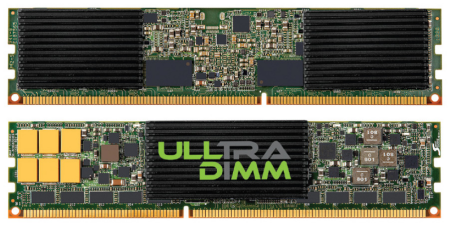
“The ULLtraDIMM SSD was designed to expand the reach of flash storage throughout the data center and scale to meet the requirements of any enterprise application - no matter how bandwidth or capacity intensive,” said John Scaramuzzo, senior vice president and general manager, Enterprise Storage Solutions at SanDisk. “We are very excited to partner with Supermicro in offering this innovative, ultra-low latency storage solution to help their customers accelerate the performance of their cloud, virtualization, HPC and other applications and experience the benefits of a flash-transformed data center.”
- Details
- Flash Memory
PMC, the semiconductor and software solutions innovator transforming networks that connect, move and store big data, today established a new ultra-fast storage class memory tier to accelerate critical applications in scale-out storage and all-flash arrays. The PMC Flashtec NVRAM Drives combine the speed and endurance of DRAM with the persistency of NAND flash to deliver ten times higher performance than the fastest Solid State Drive (SSD), at more than 10 million I/Os per second (IOPS), with sub-microsecond latency. Leveraging PCI Express (PCIe) 3.0, the Flashtec NVRAM Drives connect directly to the host to optimize CPU utilization and maximize overall system performance. The latest member of PMC’s enterprise-class Flashtec portfolio of controllers and drives, the new solutions are based on the industry-standard NVMe interface to enable plug-and-play PCIe connectivity, which decreases time to market in data center and enterprise storage deployments.
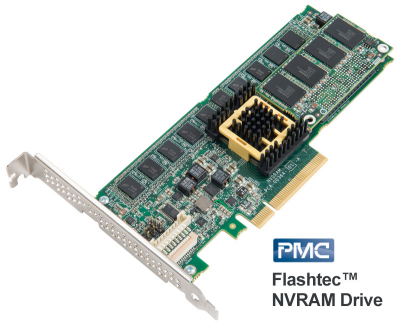
“Native PCIe-based solutions are a major disruption to the SSD market because they provide a direct link between the CPU and flash, breaking the traditional performance scale,” said Derek Dicker, vice president of the NVM Solutions Group at PMC. “The PMC Flashtec family sets a new benchmark for storage performance, and our standards-based architecture allows our customers to get their storage solutions to market much sooner with differentiated features tuned for cost, performance and endurance.”
- Details
- Flash Memory
BiTMICRO Networks, Inc. today announced MAXio E-Series PCIe solid state drives (SSDs). Powered by BiTMICRO's patented Talino ASIC Architecture, the new MAXio E-Series SSD delivers superior capacity, performance and reliability for companies that need to support high volume application workloads.
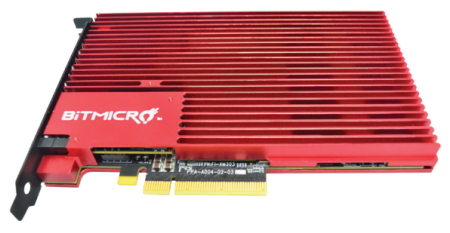
BiTMICRO MAXio E-Series SSDs are based on the company's industry proven Talino ASIC Architecture which is used by strategic partners including RunCore, one of the largest manufacturers and suppliers of solid state products and solutions in China. "BiTMICRO has developed a truly revolutionary architecture that is very high performance, but also high capacity to meet the burgeoning application demands of our customers in China and around the globe," said Limuel Yap, Vice President, Technical and Business Development, RunCore. "It changes the way people think and address their enterprise storage requirements."
- Details
- Flash Memory
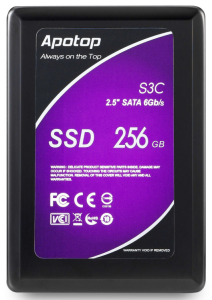 Apotop, maker of creative electronics and peripherals, has released the S3C SATA III SSD with SM2246 controller and Synchronous NAND Flash coming in 64GB, 128GB, 256GB, and 512GB sizes.
Apotop, maker of creative electronics and peripherals, has released the S3C SATA III SSD with SM2246 controller and Synchronous NAND Flash coming in 64GB, 128GB, 256GB, and 512GB sizes.
Upgrade and speed up your computer with the Apotop S3C SSD which uses cutting-edge solid state architecture with a SM2246 controller with Synchronous NAND flash, capable of reaching sequential read speeds of up to 500MB/s. The S3C also allows for exceptionally quick file transfers during editing and backup because of the supported 300MB/s sequential write speed.
The Apotop S3C SSD is Ultra Slim and only 7mm in height. The S3C comes with a 3 year limited warranty and has RoHS, CE, FCC, VCCI and BSMI certifications.
The S3C uses NAND Flash Multi-Level Cell (MLC) NAND Synchronous Flash Memory and the SATA III 6Gb/s Interface is backwards compatible with SATA II 3Gb/s. It features the Trim command and has support for a max of 4k write IOPS along with RAID support
Add a comment- Details
- Flash Memory
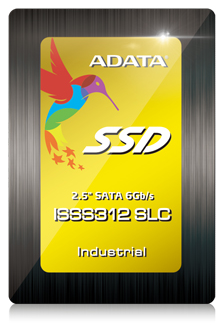 ADATA Technology, a leading manufacturer of high-performance DRAM modules and NAND Flash application products, today launches the industrial grade ISSS312 2.5” SATA III (6Gb/s) Solid State Drive. It features low power consumption, industrial grade S.M.A.R.T. and power loss protection (PLP) for excellent performance and reliability. It also provides MLC, A+ SLC, SLC grades and wide temperature to meet the upgrade requirements of industrial equipment and enterprise devices.
ADATA Technology, a leading manufacturer of high-performance DRAM modules and NAND Flash application products, today launches the industrial grade ISSS312 2.5” SATA III (6Gb/s) Solid State Drive. It features low power consumption, industrial grade S.M.A.R.T. and power loss protection (PLP) for excellent performance and reliability. It also provides MLC, A+ SLC, SLC grades and wide temperature to meet the upgrade requirements of industrial equipment and enterprise devices.
Since storage applications are rapidly changing, the concepts of consumer digital lifestyles and the Internet of Things (I.O.T.) are developing, and web applications and technology are growing sharply, the industrial equipment and enterprise platforms need more powerful data computing capability, real-time transfer rate and high I/O throughput to cope with future trends. The ADATA ISSS312 2.5” SATA 6Gb/s SSD provides solutions of MLC, A+ SLC, and SLC grades with the sequential read/write speed up to 530/500 MB/s and MTBF of up to 2 million hours. In addition, the low power consumption of 2W can effectively save power and extend the lifespan of devices. With excellent performance and durability, the ISSS312 is perfect for long-term operations of industrial systems. The industrial grade extends temperature range of -40°C to +85°C, which is suitable for high-end instruments and equipment in harsh environments.
- Details
- Flash Memory
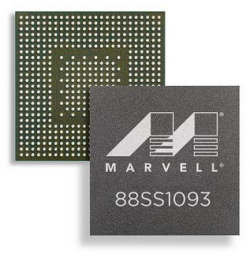 Marvell today announced the introduction of its first native Non-Volatile Memory Express (NVMe) solid-state drive (SSD) controller, the 88SS1093. The Marvell 88SS1093 NVMe SSD controller delivers high-performance solid-state storage solutions with a fully Flash-optimized architecture overcoming the SAS/SATA performance limitations by optimizing hardware and software to take full advantage on NAND and addressing the needs of data centers and client systems that utilize next-generation PCIe 3.0 SSD storage. The 88SS1093 also integrates Marvell’s third generation NANDEdge™ error-correcting, low-density parity check (LDPC) technology for higher reliability and endurance boost that was previously announced with Marvell’s fifth generation SATA SSD controller, the 88SS1074.
Marvell today announced the introduction of its first native Non-Volatile Memory Express (NVMe) solid-state drive (SSD) controller, the 88SS1093. The Marvell 88SS1093 NVMe SSD controller delivers high-performance solid-state storage solutions with a fully Flash-optimized architecture overcoming the SAS/SATA performance limitations by optimizing hardware and software to take full advantage on NAND and addressing the needs of data centers and client systems that utilize next-generation PCIe 3.0 SSD storage. The 88SS1093 also integrates Marvell’s third generation NANDEdge™ error-correcting, low-density parity check (LDPC) technology for higher reliability and endurance boost that was previously announced with Marvell’s fifth generation SATA SSD controller, the 88SS1074.
“As the global leader of the storage industry, we are very proud of our innovation, invention, and contribution to the advancement of a wide range of storage technologies and products. I am very excited to see that our new SSD controller solution has once again raised the technology bar with superior performance, high reliability and robust security,”said Weili Dai, President and Co-Founder of Marvell. “I am very proud of our close collaboration with leading tier one OEM and ODM partners around the world in enabling the rapid growth of the SSD market from client devices to data centers and enterprise systems. At Marvell, it is our pride and long term commitment to drive innovation to better lives for all in the new era of ‘Smart Life and Smart Lifestyle’.”
- Details
- Flash Memory
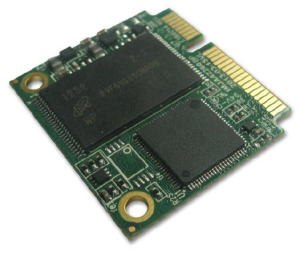 Super Talent Technology, a leading manufacturer of NAND Flash storage solutions, announces its updated mSATA SSD drives.
Super Talent Technology, a leading manufacturer of NAND Flash storage solutions, announces its updated mSATA SSD drives.
Super Talent's mSATA SSD line provides a solution for mobile computing where saving physical space is an absolute necessity. As the mobile market continues to grow, so does the demand for high capacity storage in small form factors. Built to the MO-300B form factor standard, Super Talent mSATA SSDs are the perfect solution for mobile devices.
These mSATA SSDs are built with high quality NAND flash to provide the best performance possible. The mSATA has read speeds of up to 160 MB/s and write speeds of up to 80 MB/s while the mini SJ1 boasts read speeds up to 300 MB/s and write speeds up to 100 MB/s for fast application loading.
- Details
- Flash Memory
PNY Technologies ("PNY) considered one of the worldwide leaders in consumer electronics market and memory products, has officially announced the release of the HP TF Class 10 memory cards, in current age the need for more data storage has become more important than ever. The HP TF Micro SDHC and SDXC class 10 significantly improves a consumer's digital lifestyle and to bring breakthrough performance in speed and capacity, it's the fast data transfer speed, making it an ideal storage media.

The HP TF Class 10 is available in 8GB, 16GB, 32GB and 64GB, and the speed rating of Class 10 provides unrivalled read/write performance clocked at a minimum of 10MB/s and are compatible with many of the latest mobiles phones including Android smartphones, BlackBerry Devises, GPS systems, mobile gaming consoles, also with devices ranging from the latest hi-megapixel cameras and HD camcorders to hi-end DSLRs, laptops, and the increasingly popular Tablet PCs and also provides faster data transfer rates and the various capacities help satisfy storage needs for users, from high-resolution pictures, high-quality music, to numerous downloaded applications.
- Details
- Flash Memory
Enterprise storage leader HGST, a Western Digital company, today is previewing a new architecture for solid-state drives (SSDs) that enables applications to provide faster insights to the data-intensive questions of tomorrow. The demonstration shows unprecedented SSD performance levels that are achieved by utilizing a combination of HGST’s new, latency-optimized interface protocols with next-generation non-volatile memory components.
The SSD demonstration utilizes a PCIe interface and delivers three million random read IOs per second of 512 Bytes each when operating in a queued environment and a random read access latency of 1.5 microseconds (us) in non-queued settings, delivering results that cannot be achieved with existing SSD architectures and NAND Flash memories. This performance is orders of magnitude faster than existing Flash based SSDs, resulting in a new class of block storage devices.
“The PCM SSD demonstration is a great example for how HGST sets the pace of the rapidly evolving storage industry,” said Steve Campbell, chief technology officer, HGST. “This technology is the result of several years of research and advanced development aimed at delivering new levels of acceleration for enterprise applications. The combination of HGST’s low-latency interface protocol and next-generation non-volatile memories delivers unprecedented performance, and creates exciting opportunities for new software and system architectures that HGST is exploring with our customers and industry partners.”
- Details
- Flash Memory
HGST, a Western Digital company, today announced the launch of its new FlashMAX III family of PCIe accelerators, which deliver a dramatic improvement in price/performance for today’s most demanding database and cloud workloads. Also introduced today is the new HGST ServerCache software that allows IT administrators to inject acceleration into their existing storage infrastructure by quickly and easily deploying a hybrid flash environment with any SSD.
“For businesses to remain competitive, application performance matters. Data needs to be instantly accessible for real-time processing, analytics and insights,” said Ulrich Hansen, vice president of SSD product marketing, HGST. “To address this need, enterprise customers are actively looking to add flash into their storage infrastructure. Whether focused on peak application acceleration with an all-SSD environment, improving lagging performance by tiering or using caching to leverage combined HDD and flash environments, our new hardware and software solutions help strike that balance among performance, complexity and cost.”
HGST’s new FlashMAX III PCIe SSD and ServerCache software are suited for performance-intensive applications including databases, SQL servers, data warehouses, big data deployment and video post-production applications. Each address distinct needs for flash storage solutions based on performance, capacity, cost and deployment time requirements.

